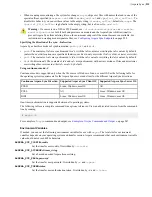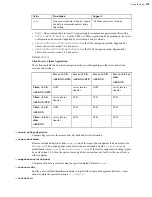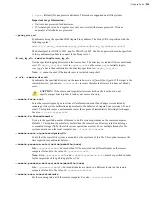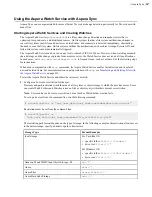
| Aspera Sync |
248
• The async session uses two threads, one for files larger than 100 KB and one for files less than or equal to 100
KB, specified with the
--transfer-threads
option.
4. Non-continuous push synchronization through reverse IBM Aspera Proxy:
$ async -N pushproxy -d /images -r [email protected]:/data/images --
proxy=dnats://gazelle:[email protected] -K push
Details:
• The transfer username on the destination (10.0.0.1) is lion, the Proxy IP address is 10.0.0.4, and the Proxy
username is gazelle.
• The Proxy URL option must include the Proxy user's password.
Async Output Example
When
async
is run in interactive mode, the status of each file in the synchronized directory is displayed in a list
similar to the following:
/file1 SYNCHRONIZED
/file2 SYNCHRONIZED(exs)
/file3 SYNCHRONIZED(skp)
/file4 SYNCHRONIZED(del)
The status may be one of the following options:
•
SYNCHRONIZED
: file transferred
•
SYNCHRONIZED(skp)
: file skipped
•
SYNCHRONIZED(del)
: file deleted
•
SYNCHRONIZED(ddp)
: dedup (duplicate files present)
•
SYNCHRONIZED(exs)
: file exists
•
SYNCHRONIZED(mov)
: file has changed (renamed, moved, or different attributes)
Include and Exclude Filtering Rules
Filtering rules can be specified in the
async
command line or in the client or server configuration (
aspera.conf
)
to include or exclude files and directories from Aspera Sync scanning and transfer. Rules in
aspera.conf
are
applied before rules specified in the command line.
Command Line Syntax
To specify an include or exclude rule on the command line, use:
--exclude="
RULE
"
--include="
RULE
"
Where:
•
RULE
is a file or directory name, or a set of names expressed with UNIX
glob
patterns.
• Surround patterns that contain wildcards with double quotes to prevent filter patterns from being interpreted by the
command shell. Patterns that do not contain wildcards can also be in double quotes.
To read include and exclude rules from a file, use:
--exclude-from=FILE
--include-from=FILE
Where:
•
FILE
is a file that contains a set of file and directory names, or names expressed with UNIX
glob
patterns.














































